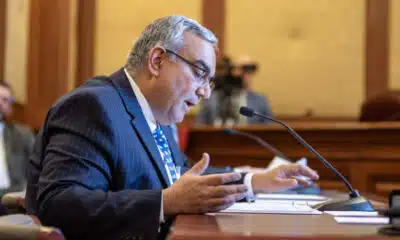Kaiser Health News
These Appalachia Hospitals Made Big Promises to Gain a Monopoly. They’re Failing to Deliver.
Brett Kelman and Samantha Liss
Fri, 29 Sep 2023 09:00:00 +0000
JOHNSON CITY, Tenn. — Five years ago, rival hospital companies in this blue-collar corner of Appalachia made a deal. If state lawmakers let them merge, leaving no competitors, the hospitals promised not to gouge prices or cut corners. They agreed to dozens of quality-of-care conditions, spelled out with benchmarks, and to provide hundreds of millions of dollars in charity care to patients in need.
Today, Ballad Health’s 20 hospitals remain the only option for hospital care for most of about 1.1 million residents in a 29-county region at the nexus of Tennessee, Virginia, Kentucky, and North Carolina. But Ballad has not met many of the quality benchmarks nor provided much of the charity, spurring discontent among those with no choice but to rely on Ballad for their care.
Two dozen states, from Florida to Washington, have at some point passed so-called COPA laws that allow hospital systems to merge into monopolies, disregarding warnings from the Federal Trade Commission that such mergers can become difficult to control and may decrease the overall quality of care. In the case of Ballad, the nation’s largest-known COPA deal, public records suggest that is exactly what happened.
Documents released by the Tennessee Department of Health show:
- Ballad has not fulfilled the annual charity care obligation it made to Tennessee, falling short by about $148 million over a four-year span. In those same years, Ballad took thousands of patients to court to collect unpaid bills.
- Ballad failed to meet about 80% of benchmarks designed to monitor and improve its quality of care — including rates of infection and death — in the most recent year for which data is available. Federal health officials cited some of these same problems this year in issuing one-star ratings to three Ballad hospitals, including a flagship, Johnson City Medical Center.
“The state of Virginia and the state of Tennessee took a chance on [Ballad] to do the right thing,” said Michele Johnson, executive director of the Tennessee Justice Center, a nonprofit focused on health care for the poor. “And they’ve proven that they are not worthy of that chance.”
In a two-hour interview with KFF Health News, Ballad Health CEO Alan Levine defended the merger as “hugely successful” for a region rife with poverty and sickness, saying his company had planted seeds of better health that “you can’t quantify today.” More specifically, Levine said the enormous pressure of the coronavirus pandemic caused Ballad’s slumping quality of care. He attributed charity care shortfalls to Medicaid changes beyond Ballad’s control and new preventive care programs that keep patients out of the hospital so they don’t need charity.
Levine said the Ballad merger had likely prevented at least three hospital closures and kept giant corporations from swooping into Appalachia to buy up the scraps.
“Our critics say, ‘No Ballad. We don’t want Ballad.’ Well, then what?” Levine said. “Because the hospitals were on their way to being closed.”
Ballad is centered in Tennessee and Virginia’s Tri-Cities region, a cluster of hardscrabble towns and wooded foothills that is home to the famous Bristol Motor Speedway and recognized by Congress as “the birthplace of Country Music.” Census data shows the Tri-Cities poverty rate is about 30% higher than the national average, and residents’ general health is below average for the nation and their respective states, according to the BlueCross BlueShield National Health Index.
Ballad launched in 2018 after state officials approved the nation’s largest-known Certificate of Public Advantage, or COPA, agreement, which waived anti-monopoly laws so the region’s only two hospital systems — Mountain States Health Alliance and Wellmont Health System — could merge. To offset the perils of a monopoly, the COPA requires Ballad to agree to increased oversight by the state and a long list of special conditions, including limiting price increases, maintaining quality, and providing charity care. Ballad also committed to investing $308 million over 10 years to improve the health of the region, some of which it has spent on a low-to-no-cost care network for the uninsured and expanded addiction treatment services.
Even with this spending, Ballad has turned a profit. The company generated net income of more than $143 million and $63 million in fiscal years 2022 and 2021, respectively, while receiving $175 million in pandemic relief funds, according to an S&P Global Ratings independent analysis, which excludes items like gains and losses separate from hospital operations.
The merger was profitable for Levine too. His total compensation has nearly doubled to about $4.3 million since the merger, including some deferred retirement payments, according to reports filed with the IRS. Prior to Ballad, Levine worked as a high-level health official in Florida and Louisiana and was an executive at two larger hospital corporations, HCA Healthcare and Health Management Associates. Federal prosecutors accused both companies of widespread health care fraud during some of the years when Levine was one of their leaders, claims the companies denied but later paid hundreds of millions of dollars to settle.
Nationwide, the COPA model is uncommon but gaining momentum. COPAs have been used in about 10 hospital mergers over the past three decades, including two in Texas and one in Louisiana in just the past three years, and another is being proposed in Indiana. Nineteen states have laws on the books allowing for COPAs, although not all have approved a specific merger, and five other states passed COPA laws and later repealed them, according to The Source on HealthCare Price & Competition, a website by the University of California College of the Law-San Francisco.
Rahul Rao, a deputy director of the Bureau of Competition at the Federal Trade Commission, which consistently opposes COPAs, said removing hospital competition leads to predictable results — rising prices, decreasing quality, and monopolies that are very hard to break up.
Rao said the FTC has for years studied how the Ballad merger is affecting health care in the region but that it is not yet ready to publish its findings.
“States should be very wary and distrustful of COPAs in general,” Rao said. “It’s very hard to unscramble the eggs.”
Tennessee began to pave the way for Ballad in 2015 when state Sen. Rusty Crowe (R-Johnson City) co-sponsored a bill allowing for the merger, which was later mirrored in Virginia. Crowe was also working as a contractor for Mountain States Health Alliance when the bill was introduced, and since the merger he has been similarly contracted with Ballad, the lawmaker said.
Tennessee financial disclosure records confirm Crowe was paid by both hospital systems but don’t say how much or for what. Crowe, who did not agree to an interview, said in an email that he was hired to “help in the development of wound care and hyperbaric medicine” and that he “complied with all the Senate ethics code requirements regarding any potential conflict of interest.”
Tennessee and Virginia health officials have concluded annually that the merger remains beneficial to the public and, in reports and interviews, credited Ballad for weathering the pandemic and keeping hospitals open.
Dennis Barry, one of the state monitors hired to keep tabs on Ballad, said he believed Ballad had largely lived up to the agreement, or at least the “intent.” Barry dismissed the FTC’s position that hospital competition is necessarily beneficial and said no one knows how the region would have fared without the merger.
“In a sense, we’ll never be able to determine whether or not this was a good idea or a bad idea,” Barry said. “I view it as an experiment.”
As Ballad fell short of its COPA benchmarks, state officials took steps to relax the oversight of its hospitals, particularly in Tennessee. Both Tennessee and Virginia gave Ballad more time to spend tens of millions to benefit the region, and Tennessee officials have repeatedly waived Ballad’s annual charity care obligation. Tennessee in 2021 stopped publishing a “final score” for Ballad’s adherence to the COPA terms and in 2022 revised COPA rules so Ballad could oppose the opening of competing hospitals or other medical facilities in the region, according to state documents. A local COPA advisory council, created to hear complaints from residents, no longer hosts public hearings.
Ballad Cites Pandemic Amid Quality Decline
Ballad has failed to meet quality-of-care benchmarks established in the COPA agreement in recent years, according to public reports from the Tennessee government and the hospital system itself. For example, a Tennessee report shows that from July 2021 through June 2022, Ballad hospitals fell short of 61 of 75 benchmarks, including some about sepsis, surgery-related infections, emergency room speed, and rates of readmission and death from heart failure.
The Centers for Medicare & Medicaid Services this year issued one-star ratings to three Ballad hospitals, all of which had ratings of at least two stars before the merger. Because CMS calculates star ratings from data collected over several years, the ratings released this year are the first to grade the Ballad hospitals entirely on post-merger data.
Levine, citing arguments similar to those of other hospital leaders, insisted the CMS five-star rating system is broken because it judges hospitals on a sliver of patients and doesn’t account for poor health in the region. He said Ballad fell short of the COPA benchmarks because the coronavirus overwhelmed hospitals and sparked an unprecedented nursing turnover.
But Ballad’s hospitals have since rebounded, Levine said, pointing to partial data on the company website — not yet reported by the states — that appears to show improving performance as of this summer. And Levine said internal data showed Ballad was now tracking with the top 10% of U.S. hospitals on some quality-of-care metrics.
“We went way backwards during covid, no question about it. And now we’ve emerged out of covid,” Levine said. “We’re recovering faster than other people.”
Erik Bodin, a Virginia Department of Health official who oversees the agreement with Ballad, said the pandemic caused quality issues at hospitals across the state, including Ballad’s, which were “not acceptable” but “to some extent understandable.” Bodin said Virginia still has “concerns” and is “watching very closely” because not all of Ballad’s metrics are rebounding.
The Tennessee Department of Health, which has the most robust role in regulating Ballad, declined an interview request and did not answer questions submitted in writing.
Ballad has also cut back on facilities for patients with life-threatening conditions. Citing redundancy with other hospitals, it downgraded the capabilities of trauma centers at Bristol Regional Medical Center and Holston Valley Medical Center and closed the intensive care unit at Sycamore Shoals Hospital. Ballad also shuttered the Holston Valley neonatal ICU. Residents were so angry that protesters gathered outside Holston Valley for eight months.
“I packed a sleeping bag, a backpack, and my laptop bag. I made two signs in my living room,” said Dani Cook, the protest leader and grandmother of a former Holston Valley NICU patient. “And next thing you know, 50 people showed up.”
One month after Holston Valley’s trauma center was downgraded, Jeremiah Shane Fields, 37, died at the hospital from chest injuries sustained in a car crash. According to a CMS investigation report obtained by KFF Health News, Fields’ blood pressure dropped for hours before his death, but his doctor did not come to his bedside as his condition deteriorated.
Holston Valley’s chief medical officer, who is quoted in the report but not named, called the case a “fundamental failure of basic trauma care” in which Fields’ doctor was “not following essential standards,” according to the report. Holston Valley was cited for “deficiencies” that were likely to harm patients, which the hospital immediately corrected, the report states.
Fields’ family has filed an ongoing lawsuit alleging negligent care, and Ballad Health has denied all wrongdoing in court filings. Molly Luton, a spokesperson for Ballad, said that Fields’ death was “an outlier” and “not the result of a systemic issue.”
Fields’ mother, Penny Meade, 59, said she believed the hospital could have done more to save her son.
“It used to be wonderful,” Meade said. “But then everything changed. They took it all away, after that merger.”
‘Helping People’ vs. ‘Coming After Them’
Ballad has fallen short of the annual charity care commitment in the COPA agreement by about $20 million to $48 million each year, according to Tennessee Department of Health documents. The agency waived this obligation each year after it wasn’t met, the documents show.
Charity care comes in two forms: free or discounted care for low-income patients, or the amount left over when Medicaid patients are treated but their entire cost is not covered. Most of Ballad’s charity care is from the second scenario, the documents show.
Ballad said in its annual reports it is unable to meet its charity care obligation because after the COPA was negotiated both Tennessee and Virginia increased their Medicaid reimbursement and Virginia expanded Medicaid to cover more people, leaving fewer people uninsured and in need of charity. (Tennessee has not expanded Medicaid.)
Levine added that Ballad’s new Appalachian Highlands Care Network provides preventive care to uninsured residents.
“We are doing everything we can, for instance, to manage their diabetes so that they don’t end up with a spike and end up in the ER,” Levine said. “That reduces your charity care.”
Some are unconvinced. Chris Garmon, a former FTC economist and a leading expert on COPAs at the University of Missouri-Kansas City, said Ballad had put forth a “strange defense” for its lack of charity care in a state where so many are uninsured.
“Last time I checked, Tennessee had not expanded Medicaid,” Garmon said. “This sounds like Ballad is pushing the envelope, like a toddler, trying to see when their parents will actually institute some discipline.”
As it was falling short of its charity commitment, Ballad filed thousands of debt collection lawsuits against patients in its first two years of operation, according to reporting from The New York Times and Modern Healthcare.
Levine said that Ballad does not sue patients who qualify for charity care and that its lawsuits slowed significantly after it adopted a more generous charity care policy in 2020. Ballad now offers free care to those who live at or below 225% of the federal poverty level, or an income of less than $67,500 for a family of four.
But the company still takes many patients to court. For example, in Tennessee’s Sullivan County, one of the most populous areas in Ballad’s market, the company has filed about 500 lawsuits since enacting the new charity care policy, court records show.
Wendy McClanahan, 44, said Ballad started garnishing her paycheck this summer over a lingering debt from a 2017 surgery. McClanahan said she was unemployed and unable to afford the bill at the time and she believed it was written off until court papers arrived in the mail.
Ballad will take 25% of McClanahan’s paycheck until she has paid off $2,747, court records show. McClanahan said she’s working overtime at her office job to make up for the lost income.
“They’re supposed to be helping people instead of coming after them,” she said. “It’s a lot of money to me, you know, and nothing to them.”
KFF Health News correspondent Bram Sable-Smith contributed to this report.
——————————
By: Brett Kelman and Samantha Liss
Title: These Appalachia Hospitals Made Big Promises to Gain a Monopoly. They’re Failing to Deliver.
Sourced From: kffhealthnews.org/news/article/appalachia-ballad-health-copa-monopoly-charity-care-quality/
Published Date: Fri, 29 Sep 2023 09:00:00 +0000
Kaiser Health News
How To Find the Right Medical Rehab Services
Rehabilitation therapy can be a godsend after hospitalization for a stroke, a fall, an accident, a joint replacement, a severe burn, or a spinal cord injury, among other conditions. Physical, occupational, and speech therapy are offered in a variety of settings, including at hospitals, nursing homes, clinics, and at home. It’s crucial to identify a high-quality, safe option with professionals experienced in treating your condition.
What kinds of rehab therapy might I need?
Physical therapy helps patients improve their strength, stability, and movement and reduce pain, usually through targeted exercises. Some physical therapists specialize in neurological, cardiovascular, or orthopedic issues. There are also geriatric and pediatric specialists. Occupational therapy focuses on specific activities (referred to as “occupations”), often ones that require fine motor skills, like brushing teeth, cutting food with a knife, and getting dressed. Speech and language therapy help people communicate. Some patients may need respiratory therapy if they have trouble breathing or need to be weaned from a ventilator.
Will insurance cover rehab?
Medicare, health insurers, workers’ compensation, and Medicaid plans in some states cover rehab therapy, but plans may refuse to pay for certain settings and may limit the amount of therapy you receive. Some insurers may require preauthorization, and some may terminate coverage if you’re not improving. Private insurers often place annual limits on outpatient therapy. Traditional Medicare is generally the least restrictive, while private Medicare Advantage plans may monitor progress closely and limit where patients can obtain therapy.
Should I seek inpatient rehabilitation?
Patients who still need nursing or a doctor’s care but can tolerate three hours of therapy five days a week may qualify for admission to a specialized rehab hospital or to a unit within a general hospital. Patients usually need at least two of the main types of rehab therapy: physical, occupational, or speech. Stays average around 12 days.
How do I choose?
Look for a place that is skilled in treating people with your diagnosis; many inpatient hospitals list specialties on their websites. People with complex or severe medical conditions may want a rehab hospital connected to an academic medical center at the vanguard of new treatments, even if it’s a plane ride away.
“You’ll see youngish patients with these life-changing, fairly catastrophic injuries,” like spinal cord damage, travel to another state for treatment, said Cheri Blauwet, chief medical officer of Spaulding Rehabilitation in Boston, one of 15 hospitals the federal government has praised for cutting-edge work.
But there are advantages in selecting a hospital close to family and friends who can help after you are discharged. Therapists can help train at-home caregivers.
How do I find rehab hospitals?
The discharge planner or caseworker at the acute care hospital should provide options. You can search for inpatient rehabilitation facilities by location or name through Medicare’s Care Compare website. There you can see how many patients the rehab hospital has treated with your condition — the more the better. You can search by specialty through the American Medical Rehabilitation Providers Association, a trade group that lists its members.
Find out what specialized technologies a hospital has, like driving simulators — a car or truck that enable a patient to practice getting in and out of a vehicle — or a kitchen table with utensils to practice making a meal.
How can I be confident a rehab hospital is reliable?
It’s not easy: Medicare doesn’t analyze staffing levels or post on its website results of safety inspections as it does for nursing homes. You can ask your state public health agency or the hospital to provide inspection reports for the last three years. Such reports can be technical, but you should get the gist. If the report says an “immediate jeopardy” was called, that means inspectors identified safety problems that put patients in danger.
The rate of patients readmitted to a general hospital for a potentially preventable reason is a key safety measure. Overall, for-profit rehabs have higher readmission rates than nonprofits do, but there are some with lower readmission rates and some with higher ones. You may not have a nearby choice: There are fewer than 400 rehab hospitals, and most general hospitals don’t have a rehab unit.
You can find a hospital’s readmission rates under Care Compare’s quality section. Rates lower than the national average are better.
Another measure of quality is how often patients are functional enough to go home after finishing rehab rather than to a nursing home, hospital, or health care institution. That measure is called “discharge to community” and is listed under Care Compare’s quality section. Rates higher than the national average are better.
Look for reviews of the hospital on Yelp and other sites. Ask if the patient will see the same therapist most days or a rotating cast of characters. Ask if the therapists have board certifications earned after intensive training to treat a patient’s particular condition.
Visit if possible, and don’t look only at the rooms in the hospital where therapy exercises take place. Injuries often occur in the 21 hours when a patient is not in therapy, but in his or her room or another part of the building. Infections, falls, bedsores, and medication errors are risks. If possible, observe whether nurses promptly respond to call lights, seem overloaded with too many patients, or are apathetically playing on their phones. Ask current patients and their family members if they are satisfied with the care.
What if I can’t handle three hours of therapy a day?
A nursing home that provides rehab might be appropriate for patients who don’t need the supervision of a doctor but aren’t ready to go home. The facilities generally provide round-the-clock nursing care. The amount of rehab varies based on the patient. There are more than 14,500 skilled nursing facilities in the United States, 12 times as many as hospitals offering rehab, so a nursing home may be the only option near you.
You can look for them through Medicare’s Care Compare website. (Read our previous guide to finding a good, well-staffed home to know how to assess the overall staffing.)
What if patients are too frail even for a nursing home?
They might need a long-term care hospital. Those specialize in patients who are in comas, on ventilators, and have acute medical conditions that require the presence of a physician. Patients stay at least four weeks, and some are there for months. Care Compare helps you search. There are fewer than 350 such hospitals.
I’m strong enough to go home. How do I receive therapy?
Many rehab hospitals offer outpatient therapy. You also can go to a clinic, or a therapist can come to you. You can hire a home health agency or find a therapist who takes your insurance and makes house calls. Your doctor or hospital may give you referrals. On Care Compare, home health agencies list whether they offer physical, occupational, or speech therapy. You can search for board-certified therapists on the American Physical Therapy Association’s website.
While undergoing rehab, patients sometimes move from hospital to nursing facility to home, often at the insistence of their insurers. Alice Bell, a senior specialist at the APTA, said patients should try to limit the number of transitions, for their own safety.
“Every time a patient moves from one setting to another,” she said, “they’re in a higher risk zone.”
KFF Health News is a national newsroom that produces in-depth journalism about health issues and is one of the core operating programs at KFF—an independent source of health policy research, polling, and journalism. Learn more about KFF.
USE OUR CONTENT
This story can be republished for free (details).
KFF Health News is a national newsroom that produces in-depth journalism about health issues and is one of the core operating programs at KFF—an independent source of health policy research, polling, and journalism. Learn more about KFF.
Subscribe to KFF Health News’ free Morning Briefing.
This article first appeared on KFF Health News and is republished here under a Creative Commons license.
The post How To Find the Right Medical Rehab Services appeared first on kffhealthnews.org
Note: The following A.I. based commentary is not part of the original article, reproduced above, but is offered in the hopes that it will promote greater media literacy and critical thinking, by making any potential bias more visible to the reader –Staff Editor.
Political Bias Rating: Centrist
This article from KFF Health News provides a comprehensive, fact-based guide to rehabilitation therapy options and how to navigate insurance, care settings, and provider quality. It avoids ideological framing and presents information in a neutral, practical tone aimed at helping consumers make informed medical decisions. While it touches on Medicare and private insurance policies, it does so without political commentary or value judgments, and no partisan viewpoints or advocacy positions are evident. The focus remains on patient care, safety, and informed choice, supporting a nonpartisan, service-oriented approach to health reporting.
Kaiser Health News
States Brace for Reversal of Obamacare Coverage Gains Under Trump’s Budget Bill
Shorter enrollment periods. More paperwork. Higher premiums. The sweeping tax and spending bill pushed by President Donald Trump includes provisions that would not only reshape people’s experience with the Affordable Care Act but, according to some policy analysts, also sharply undermine the gains in health insurance coverage associated with it.
The moves affect consumers and have particular resonance for the 19 states (plus Washington, D.C.) that run their own ACA exchanges.
Many of those states fear that the additional red tape — especially requirements that would end automatic reenrollment — would have an outsize impact on their policyholders. That’s because a greater percentage of people in those states use those rollovers versus shopping around each year, which is more commonly done by people in states that use the federal healthcare.gov marketplace.
“The federal marketplace always had a message of, ‘Come back in and shop,’ while the state-based markets, on average, have a message of, ‘Hey, here’s what you’re going to have next year, here’s what it will cost; if you like it, you don’t have to do anything,’” said Ellen Montz, who oversaw the federal ACA marketplace under the Biden administration as deputy administrator and director at the Center for Consumer Information and Insurance Oversight. She is now a managing director with the Manatt Health consulting group.
Millions — perhaps up to half of enrollees in some states — may lose or drop coverage as a result of that and other changes in the legislation combined with a new rule from the Trump administration and the likely expiration at year’s end of enhanced premium subsidies put in place during the covid-19 pandemic. Without an extension of those subsidies, which have been an important driver of Obamacare enrollment in recent years, premiums are expected to rise 75% on average next year. That’s starting to happen already, based on some early state rate requests for next year, which are hitting double digits.
“We estimate a minimum 30% enrollment loss, and, in the worst-case scenario, a 50% loss,” said Devon Trolley, executive director of Pennie, the ACA marketplace in Pennsylvania, which had 496,661 enrollees this year, a record.
Drops of that magnitude nationally, coupled with the expected loss of Medicaid coverage for millions more people under the legislation Trump calls the “One Big Beautiful Bill,” could undo inroads made in the nation’s uninsured rate, which dropped by about half from the time most of the ACA’s provisions went into effect in 2014, when it hovered around 14% to 15% of the population, to just over 8%, according to the most recent data.
Premiums would rise along with the uninsured rate, because older or sicker policyholders are more likely to try to jump enrollment hurdles, while those who rarely use coverage — and are thus less expensive — would not.
After a dramatic all-night session, House Republicans passed the bill, meeting the president’s July 4 deadline. Trump is expected to sign the measure on Independence Day. It would increase the federal deficit by trillions of dollars and cut spending on a variety of programs, including Medicaid and nutrition assistance, to partly offset the cost of extending tax cuts put in place during the first Trump administration.
The administration and its supporters say the GOP-backed changes to the ACA are needed to combat fraud. Democrats and ACA supporters see this effort as the latest in a long history of Republican efforts to weaken or repeal Obamacare. Among other things, the legislation would end several changes put in place by the Biden administration that were credited with making it easier to sign up, such as lengthening the annual open enrollment period and launching a special program for very low-income people that essentially allows them to sign up year-round.
In addition, automatic reenrollment, used by more than 10 million people for 2025 ACA coverage, would end in the 2028 sign-up season. Instead, consumers would have to update their information, starting in August each year, before the close of open enrollment, which would end Dec. 15, a month earlier than currently.
That’s a key change to combat rising enrollment fraud, said Brian Blase, president of the conservative Paragon Health Institute, because it gets at what he calls the Biden era’s “lax verification requirements.”
He blames automatic reenrollment, coupled with the availability of zero-premium plans for people with lower incomes that qualify them for large subsidies, for a sharp uptick in complaints from insurers, consumers, and brokers about fraudulent enrollments in 2023 and 2024. Those complaints centered on consumers’ being enrolled in an ACA plan, or switched from one to another, without authorization, often by commission-seeking brokers.
In testimony to Congress on June 25, Blase wrote that “this simple step will close a massive loophole and significantly reduce improper enrollment and spending.”
States that run their own marketplaces, however, saw few, if any, such problems, which were confined mainly to the 31 states using the federal healthcare.gov.
The state-run marketplaces credit their additional security measures and tighter control over broker access than healthcare.gov for the relative lack of problems.
“If you look at California and the other states that have expanded their Medicaid programs, you don’t see that kind of fraud problem,” said Jessica Altman, executive director of Covered California, the state’s Obamacare marketplace. “I don’t have a single case of a consumer calling Covered California saying, ‘I was enrolled without consent.’”
Such rollovers are common with other forms of health insurance, such as job-based coverage.
“By requiring everyone to come back in and provide additional information, and the fact that they can’t get a tax credit until they take this step, it is essentially making marketplace coverage the most difficult coverage to enroll in,” said Trolley at Pennie, 65% of whose policyholders were automatically reenrolled this year, according to KFF data. KFF is a health information nonprofit that includes KFF Health News.
Federal data shows about 22% of federal sign-ups in 2024 were automatic-reenrollments, versus 58% in state-based plans. Besides Pennsylvania, the states that saw such sign-ups for more than 60% of enrollees include California, New York, Georgia, New Jersey, and Virginia, according to KFF.
States do check income and other eligibility information for all enrollees — including those being automatically renewed, those signing up for the first time, and those enrolling outside the normal open enrollment period because they’ve experienced a loss of coverage or other life event or meet the rules for the low-income enrollment period.
“We have access to many data sources on the back end that we ping, to make sure nothing has changed. Most people sail through and are able to stay covered without taking any proactive step,” Altman said.
If flagged for mismatched data, applicants are asked for additional information. Under current law, “we have 90 days for them to have a tax credit while they submit paperwork,” Altman said.
That would change under the tax and spending plan before Congress, ending presumptive eligibility while a person submits the information.
A white paper written for Capital Policy Analytics, a Washington-based consultancy that specializes in economic analysis, concluded there appears to be little upside to the changes.
While “tighter verification can curb improper enrollments,” the additional paperwork, along with the expiration of higher premiums from the enhanced tax subsidies, “would push four to six million eligible people out of Marketplace plans, trading limited fraud savings for a surge in uninsurance,” wrote free market economists Ike Brannon and Anthony LoSasso.
“Insurers would be left with a smaller, sicker risk pool and heightened pricing uncertainty, making further premium increases and selective market exits [by insurers] likely,” they wrote.
KFF Health News is a national newsroom that produces in-depth journalism about health issues and is one of the core operating programs at KFF—an independent source of health policy research, polling, and journalism. Learn more about KFF.
USE OUR CONTENT
This story can be republished for free (details).
KFF Health News is a national newsroom that produces in-depth journalism about health issues and is one of the core operating programs at KFF—an independent source of health policy research, polling, and journalism. Learn more about KFF.
Subscribe to KFF Health News’ free Morning Briefing.
This article first appeared on KFF Health News and is republished here under a Creative Commons license.
The post States Brace for Reversal of Obamacare Coverage Gains Under Trump’s Budget Bill appeared first on kffhealthnews.org
Note: The following A.I. based commentary is not part of the original article, reproduced above, but is offered in the hopes that it will promote greater media literacy and critical thinking, by making any potential bias more visible to the reader –Staff Editor.
Political Bias Rating: Center-Left
This content presents a critique of Republican-led changes to the Affordable Care Act, emphasizing potential negative impacts such as increased premiums, reduced enrollment, and the erosion of coverage gains made under the ACA. It highlights the perspective of policy analysts and state officials who express concern over these measures, while also presenting conservative viewpoints, particularly those focusing on fraud reduction. Overall, the tone and framing lean toward protecting the ACA and its expansions, which traditionally aligns with Center-Left media analysis.
Kaiser Health News
Dual Threats From Trump and GOP Imperil Nursing Homes and Their Foreign-Born Workers
In a top-rated nursing home in Alexandria, Virginia, the Rev. Donald Goodness is cared for by nurses and aides from various parts of Africa. One of them, Jackline Conteh, a naturalized citizen and nurse assistant from Sierra Leone, bathes and helps dress him most days and vigilantly intercepts any meal headed his way that contains gluten, as Goodness has celiac disease.
“We are full of people who come from other countries,” Goodness, 92, said about Goodwin House Alexandria’s staff. Without them, the retired Episcopal priest said, “I would be, and my building would be, desolate.”
The long-term health care industry is facing a double whammy from President Donald Trump’s crackdown on immigrants and the GOP’s proposals to reduce Medicaid spending. The industry is highly dependent on foreign workers: More than 800,000 immigrants and naturalized citizens comprise 28% of direct care employees at home care agencies, nursing homes, assisted living facilities, and other long-term care companies.
But in January, the Trump administration rescinded former President Joe Biden’s 2021 policy that protected health care facilities from Immigration and Customs Enforcement raids. The administration’s broad immigration crackdown threatens to drastically reduce the number of current and future workers for the industry. “People may be here on a green card, and they are afraid ICE is going to show up,” said Katie Smith Sloan, president of LeadingAge, an association of nonprofits that care for older adults.
Existing staffing shortages and quality-of-care problems would be compounded by other policies pushed by Trump and the Republican-led Congress, according to nursing home officials, resident advocates, and academic experts. Federal spending cuts under negotiation may strip nursing homes of some of their largest revenue sources by limiting ways states leverage Medicaid money and making it harder for new nursing home residents to retroactively qualify for Medicaid. Care for 6 in 10 residents is paid for by Medicaid, the state-federal health program for poor or disabled Americans.
“We are facing the collision of two policies here that could further erode staffing in nursing homes and present health outcome challenges,” said Eric Roberts, an associate professor of internal medicine at the University of Pennsylvania.
The industry hasn’t recovered from covid-19, which killed more than 200,000 long-term care facility residents and workers and led to massive staff attrition and turnover. Nursing homes have struggled to replace licensed nurses, who can find better-paying jobs at hospitals and doctors’ offices, as well as nursing assistants, who can earn more working at big-box stores or fast-food joints. Quality issues that preceded the pandemic have expanded: The percentage of nursing homes that federal health inspectors cited for putting residents in jeopardy of immediate harm or death has risen alarmingly from 17% in 2015 to 28% in 2024.
In addition to seeking to reduce Medicaid spending, congressional Republicans have proposed shelving the biggest nursing home reform in decades: a Biden-era rule mandating minimum staffing levels that would require most of the nation’s nearly 15,000 nursing homes to hire more workers.
The long-term care industry expects demand for direct care workers to burgeon with an influx of aging baby boomers needing professional care. The Census Bureau has projected the number of people 65 and older would grow from 63 million this year to 82 million in 2050.
In an email, Vianca Rodriguez Feliciano, a spokesperson for the Department of Health and Human Services, said the agency “is committed to supporting a strong, stable long-term care workforce” and “continues to work with states and providers to ensure quality care for older adults and individuals with disabilities.” In a separate email, Tricia McLaughlin, a Department of Homeland Security spokesperson, said foreigners wanting to work as caregivers “need to do that by coming here the legal way” but did not address the effect on the long-term care workforce of deportations of classes of authorized immigrants.
Goodwin Living, a faith-based nonprofit, runs three retirement communities in northern Virginia for people who live independently, need a little assistance each day, have memory issues, or require the availability of around-the-clock nurses. It also operates a retirement community in Washington, D.C. Medicare rates Goodwin House Alexandria as one of the best-staffed nursing homes in the country. Forty percent of the organization’s 1,450 employees are foreign-born and are either seeking citizenship or are already naturalized, according to Lindsay Hutter, a Goodwin spokesperson.
“As an employer, we see they stay on with us, they have longer tenure, they are more committed to the organization,” said Rob Liebreich, Goodwin’s president and CEO.
Jackline Conteh spent much of her youth shuttling between Sierra Leone, Liberia, and Ghana to avoid wars and tribal conflicts. Her mother was killed by a stray bullet in her home country of Liberia, Conteh said. “She was sitting outside,” Conteh, 56, recalled in an interview.
Conteh was working as a nurse in a hospital in Sierra Leone in 2009 when she learned of a lottery for visas to come to the United States. She won, though she couldn’t afford to bring her husband and two children along at the time. After she got a nursing assistant certification, Goodwin hired her in 2012.
Conteh said taking care of elders is embedded in the culture of African families. When she was 9, she helped feed and dress her grandmother, a job that rotated among her and her sisters. She washed her father when he was dying of prostate cancer. Her husband joined her in the United States in 2017; she cares for him because he has heart failure.
“Nearly every one of us from Africa, we know how to care for older adults,” she said.
Her daughter is now in the United States, while her son is still in Africa. Conteh said she sends money to him, her mother-in-law, and one of her sisters.
In the nursing home where Goodness and 89 other residents live, Conteh helps with daily tasks like dressing and eating, checks residents’ skin for signs of swelling or sores, and tries to help them avoid falling or getting disoriented. Of 102 employees in the building, broken up into eight residential wings called “small houses” and a wing for memory care, at least 72 were born abroad, Hutter said.
Donald Goodness grew up in Rochester, New York, and spent 25 years as rector of The Church of the Ascension in New York City, retiring in 1997. He and his late wife moved to Alexandria to be closer to their daughter, and in 2011 they moved into independent living at the Goodwin House. In 2023 he moved into one of the skilled nursing small houses, where Conteh started caring for him.
“I have a bad leg and I can’t stand on it very much, or I’d fall over,” he said. “She’s in there at 7:30 in the morning, and she helps me bathe.” Goodness said Conteh is exacting about cleanliness and will tell the housekeepers if his room is not kept properly.
Conteh said Goodness was withdrawn when he first arrived. “He don’t want to come out, he want to eat in his room,” she said. “He don’t want to be with the other people in the dining room, so I start making friends with him.”
She showed him a photo of Sierra Leone on her phone and told him of the weather there. He told her about his work at the church and how his wife did laundry for the choir. The breakthrough, she said, came one day when he agreed to lunch with her in the dining room. Long out of his shell, Goodness now sits on the community’s resident council and enjoys distributing the mail to other residents on his floor.
“The people that work in my building become so important to us,” Goodness said.
While Trump’s 2024 election campaign focused on foreigners here without authorization, his administration has broadened to target those legally here, including refugees who fled countries beset by wars or natural disasters. This month, the Department of Homeland Security revoked the work permits for migrants and refugees from Cuba, Haiti, Nicaragua, and Venezuela who arrived under a Biden-era program.
“I’ve just spent my morning firing good, honest people because the federal government told us that we had to,” Rachel Blumberg, president of the Toby & Leon Cooperman Sinai Residences of Boca Raton, a Florida retirement community, said in a video posted on LinkedIn. “I am so sick of people saying that we are deporting people because they are criminals. Let me tell you, they are not all criminals.”
At Goodwin House, Conteh is fearful for her fellow immigrants. Foreign workers at Goodwin rarely talk about their backgrounds. “They’re scared,” she said. “Nobody trusts anybody.” Her neighbors in her apartment complex fled the U.S. in December and returned to Sierra Leone after Trump won the election, leaving their children with relatives.
“If all these people leave the United States, they go back to Africa or to their various countries, what will become of our residents?” Conteh asked. “What will become of our old people that we’re taking care of?”
KFF Health News is a national newsroom that produces in-depth journalism about health issues and is one of the core operating programs at KFF—an independent source of health policy research, polling, and journalism. Learn more about KFF.
Subscribe to KFF Health News’ free Morning Briefing.
This article first appeared on KFF Health News and is republished here under a Creative Commons license.
The post Dual Threats From Trump and GOP Imperil Nursing Homes and Their Foreign-Born Workers appeared first on kffhealthnews.org
Note: The following A.I. based commentary is not part of the original article, reproduced above, but is offered in the hopes that it will promote greater media literacy and critical thinking, by making any potential bias more visible to the reader –Staff Editor.
Political Bias Rating: Center-Left
This content primarily highlights concerns about the impact of restrictive immigration policies and Medicaid spending cuts proposed by the Trump administration and Republican lawmakers on the long-term care industry. It emphasizes the importance of immigrant workers in healthcare, the challenges that staffing shortages pose to patient care, and the potential negative effects of GOP policy proposals. The tone is critical of these policies while sympathetic toward immigrant workers and advocates for maintaining or increasing government support for healthcare funding. The framing aligns with a center-left perspective, focusing on social welfare, immigrant rights, and concern about the consequences of conservative economic and immigration policies without descending into partisan rhetoric.
-
News from the South - Texas News Feed4 days ago
Racism Wrapped in Rural Warmth
-
News from the South - Texas News Feed6 days ago
DEA agents uncover 'torture chamber,' buried drugs and bones at Kentucky home
-
Our Mississippi Home7 days ago
Spit Me Out Quick – How Lubber Grasshoppers Survive
-
News from the South - Florida News Feed7 days ago
Chinese bridge collapse kills at least 12 construction workers
-
News from the South - Missouri News Feed5 days ago
Donors to private school voucher program removed from Missouri transparency site
-
News from the South - Florida News Feed6 days ago
Ukraine’s independence-era voices say Russia’s effort to keep control has lasted decades
-
News from the South - Alabama News Feed4 days ago
Child in north Alabama has measles, says Alabama Department of Public Health
-
News from the South - Texas News Feed5 days ago
Texas Democrats’ walkout prompts GOP retribution

















































